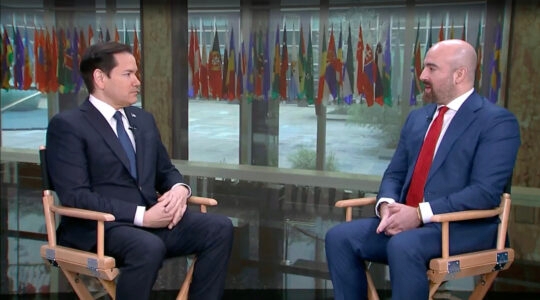LOS ANGELES (JTA) — The recent shootings at a pair of Kansas City-area Jewish facilities illustrate the persistent threat of white supremacist violence, even as broad measures of anti-Semitism continue to decline.
Suspected gunman Frazier Glenn Miller, Jr. had a long history in the white supremacist movement, dating back to the 1970s, before the recent rampage that killed three people outside the Jewish Community Center of Greater Kansas City and the nearby Village Shalom assisted living facility.
Though police believe that Miller acted alone, analysts who track white supremacist groups say that the movement has become more active in recent years, which they attribute to factors such as economic woes and the backlash against Barack Obama’s election in 2008.
“They did get much more agitated and angry, and we did see an increase in criminal activity, in violent hate crimes, acts of terrorism, plots coming out of the white supremacist movement,” said Mark Pitcavage, the Anti-Defamation League’s director of investigative research.
However, Pitcavage said, the white supremacist movement has not seen significant growth in its ranks.
Behavioral patterns among hate groups are notoriously difficult to track, as members tend to be secretive and deeply suspicious of outsiders. Most adherents to extremist causes don’t affiliate with any group at all. The landscape has become even more complex as many established white supremacist groups have collapsed into a myriad of splinter groups.
Miller’s own career illustrates the fluid world of white supremacist groups. A former U.S. Army Green Beret, Miller joined a neo-Nazi group in the late 1970s, then founded the Carolina Knights of the Ku Klux Klan in 1980, later renamed the White Patriot Party. He became a pariah in white supremacist circles after testifying against fellow movement leaders as part of a plea bargain in a 1988 federal sedition trial but then reemerged as a prominent voice around 2000, making various media appearances, including on Howard Stern’s radio show.
While far-right anti-government groups in general have experienced explosive growth over the past few years, white supremacist groups do not appear to have had a similar surge in their ranks. But that doesn’t mean the threat they pose has diminished, experts say.
“The members nowadays tend to be more dangerous — they’re more likely to commit very serious hate crimes against Jews and other groups,” said Jack Levin, a professor of sociology and criminology at Northeastern University. “The peripheral members have gotten out. The hardcore survivors are the ones who commit the really serious crimes, and they’re the ones who are left in the groups.”
At the same time, anti-Semitism has become increasingly central to the ideologies of hate groups over the decades.
“We have a radical right underworld that is very much animated by anti-Semitism,” said Mark Potok, a senior fellow at the Southern Poverty Law Center. “It’s essentially been Nazified in last 30 years. They no longer see blacks as the ultimate enemy. Jews are now considered the ultimate enemy.”
That worldview, in which white supremacists see Jews as the manipulators behind blacks, Hispanics and other perceived enemies, was reflected in Miller’s own thinking.
“Blacks, they have little power except what the Jews allow them to have,” Miller said to the liberal blog Talking Points Memo in a 2012 interview. “Jews call the shots. But white people, we have no power at all.”
That increased suspicion has not necessarily translated into more anti-Semitic activity. The Anti-Defamation League found that reported anti-Semitic incidents were down in 2013, continuing a decade-long trend.
White supremacists can sometimes find it difficult to identify Jews, even when they seek them out.
“Look at this case outside of Kansas City,” said Levin, referring to the recent shootings. “The perpetrator tried to kill Jews and mistakenly killed three Christians.”
JTA has documented Jewish history in real-time for over a century. Keep our journalism strong by joining us in supporting independent, award-winning reporting.






